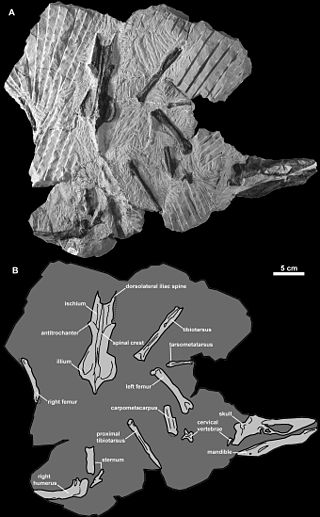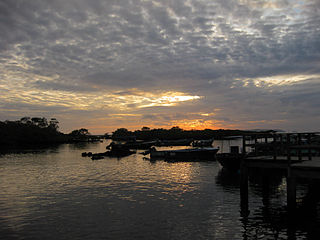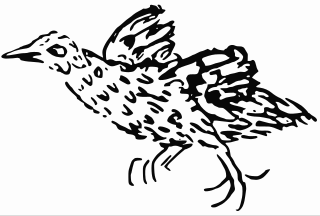
Carinatae is the group of all birds and their extinct relatives to possess a keel, or "carina", on the underside of the breastbone used to anchor large flight muscles.

A ratite is any of a group of flightless birds within the infraclass Palaeognathae. They are mostly large, long-necked, and long-legged, the exception being the Kiwi, which is also the only nocturnal extant ratite.

Rails are a large, cosmopolitan family of small- to medium-sized terrestrial and/or semi-amphibious birds. The family exhibits considerable diversity in its forms, and includes such ubiquitous species as the crakes, coots, and gallinule; other rail species are extremely rare or endangered. Many are associated with wetland habitats, some being semi-aquatic like waterfowl, but many more are wading birds or shorebirds. The ideal rail habitats are marsh areas, including rice paddies, and flooded fields or open forest. They are especially fond of dense vegetation for nesting. The rail family is found in every terrestrial habitat with the exception of dry desert, polar or freezing regions, and alpine areas. Members of Rallidae occur on every continent except Antarctica. Numerous unique island species are known.

Moorhens—sometimes called marsh hens—are medium-sized water birds that are members of the rail family (Rallidae). Most species are placed in the genus Gallinula, Latin for "little hen". They are close relatives of coots. They are often referred to as (black) gallinules. Recently, one of the species of Gallinula was found to have enough differences to form a new genus Paragallinula with the only species being the lesser moorhen.

Flightless birds are birds that, through evolution, lost the ability to fly. There are over 60 extant species, including the well-known ratites and penguins. The smallest flightless bird is the Inaccessible Island rail. The largest flightless bird, which is also the largest living bird in general, is the ostrich.

A keel or carina in bird anatomy is an extension of the sternum (breastbone) which runs axially along the midline of the sternum and extends outward, perpendicular to the plane of the ribs. The keel provides an anchor to which a bird's wing muscles attach, thereby providing adequate leverage for flight. Not all birds have keels; in particular, some flightless birds lack a keel structure. Some flightless birds have a keel, such as the penguin; but in the penguin's case, its wings are too small for its body, so flight would require flapping its wings too fast to be practical.

The steamer ducks are a genus (Tachyeres) of ducks in the family Anatidae. All of the four species occur at the southern cone of South America in Chile and Argentina, and all except the flying steamer duck are flightless; even this one species capable of flight rarely takes to the air. They can be aggressive and are capable of chasing off predators like petrels. Bloody battles of steamer ducks with each other over territory disputes are observed in nature. They even kill waterbirds that are several times their size.

Mancallinae is an extinct subfamily of prehistoric flightless alcids that lived on the Pacific coast of today's California and Mexico from the late Miocene epoch to the early Pleistocene. They are sometimes collectively referred to as Lucas auks after the scientist who described the first species, Frederic Augustus Lucas.
Barawertornis tedfordi was a dromornithid (mihirung), a large flightless fowl hailing from Late Oligocene to Early Miocene. The only species in the genus Barawertornis, its fossil remains are found in strata of the Riversleigh deposits located at two sites in Northwestern Queensland, Australia.

Palaeognathae is an infraclass of birds, called paleognaths or palaeognaths, within the class Aves of the clade Archosauria. It is one of the two extant infraclasses of birds, the other being Neognathae, both of which form Neornithes. Palaeognathae contains five extant branches of flightless lineages, termed ratites, and one flying lineage, the Neotropic tinamous. There are 47 species of tinamous, five of kiwis (Apteryx), three of cassowaries (Casuarius), one of emus (Dromaius), two of rheas (Rhea) and two of ostriches (Struthio). Recent research has indicated that paleognaths are monophyletic but the traditional taxonomic split between flightless and flighted forms is incorrect; tinamous are within the ratite radiation, meaning flightlessness arose independently multiple times via parallel evolution.

Isabela Canton is a canton of Galápagos Province, Ecuador, consisting of the islands of Isabela Island, Darwin, Fernandina, Wolf, and some minor islets. Isabela is the largest island in the Galápagos, and well known for its beaches, bays and coastal lagoons with a wide variety of plants and birds. The capital of the canton is Puerto Villamil.

The Ascension crake is an extinct flightless bird that previously lived on Ascension Island in the South Atlantic Ocean. Like many other flightless birds on isolated islands, it was a rail. It was declared extinct by Groombridge in 1994; BirdLife International confirmed this in 2000 and 2004.
Asiahesperornis is a prehistoric foot-propelled diving toothed flightless bird genus from the Late Cretaceous. The single known species is Asiahesperornis bazhanovi. It lived in what today is Kazakhstan, at its time the shores of the shallow Turgai Sea.
Judinornis is a genus of prehistoric flightless birds from the late Cretaceous period. The single known species is Judinornis nogontsavensis. Its fossils have been found in Nemegt Formation rocks of southern Mongolia, and though the age of these deposits is not fully resolved, Judinornis probably lived some 70 million years ago during the early Maastrichtian.
Pasquiaornis is a prehistoric flightless bird genus from the Late Cretaceous. It lived during the late Cenomanian, between 95 and 93 million years ago in North America.

Potamornis is a prehistoric bird genus that dated back to the late Maastrichtian age of the late Cretaceous period. Its scrappy remains were found in the Lance Formation at Buck Creek, USA, and additional possible remains were found in the upper Hell Creek Formation of Montana, dated to the Danian age of the Paleogene period, though these may have been reworked. A single species was named and described in 2001: Potamornis skutchi.
Long Mile Cave, sometimes known locally as Pick'ny Mama Cave or Hell's Gate Cave, is a palaeontological and palaeoanthropological site in the Cockpit Country of north-western Jamaica.

Miomancalla is an extinct genus of prehistoric flightless alcids that lived on the Pacific coast of today's California in the Miocene epoch. It contained two species, M. howardi and M. wetmorei.
The Pindai Caves of New Caledonia are an archaeological and palaeontological site important for the study of prehistoric human settlement as well as of the Holocene fauna of the island. The Pindai area has been occupied by humans for varying periods over the last 2,800 years.
Shiriyanetta hasegawai is an extinct species of seaduck from the Pleistocene of Japan. It was flightless, similar to the also extinct Chendytes from the opposite side of the Pacific.















